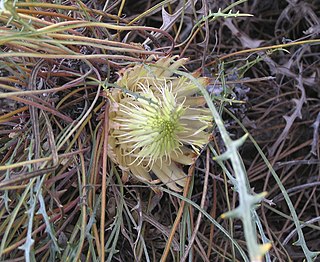
Ranunculaceae is a family of over 2,000 known species of flowering plants in 43 genera, distributed worldwide.

The peony or paeony is a flowering plant in the genus Paeonia, the only genus in the family Paeoniaceae. Peonies are native to Asia, Europe and Western North America. Scientists differ on the number of species that can be distinguished, ranging from 25 to 40, although the current consensus is 33 known species. The relationships between the species need to be further clarified.

Trixis is a genus of shrubs in the aster family, Asteraceae, native to North and South America including the West Indies.

Stephanomeria is a genus of North American plants also known as wirelettuce, belonging to the dandelion tribe within the sunflower family.

Banksia rufa is a species of prostrate shrub that is endemic to the south-west of Western Australia. It has broadly linear, pinnatifid or pinnatipartite leaves with between five and twenty lobes on each side, yellow, orange or brownish flowers in heads of forty or more, and glabrous, egg-shaped follicles.

Banksia nobilis, commonly known as the golden dryandra, great dryandra or kerosene bush, is a shrub of the family Proteaceae which is endemic to Western Australia. It occurs on lateritic rises from Eneabba to Katanning in the state's Southwest Botanic Province. With large pinnatifid leaves with triangular lobes, and a golden or reddish pink inflorescence, it is a popular garden plant. It was known as Dryandra nobilis until 2007, when all Dryandra species were transferred to Banksia by Austin Mast and Kevin Thiele. There are two subspecies, B. nobilis subsp. nobilis and B. nobilis subsp. fragrans.

Jungia is a genus of flowering plants in the sunflower family. It is native mostly to South America, with one widespread species extending its range into Central America and southern Mexico.

The Mutisioideae are a subfamily in the plant family Asteraceae that includes about 630 species assigned to 44 different genera. This subfamily is mainly native in South America, except for Adenocaulon, Chaptalia, Gerbera, Trichocline, which have species in all continents other than Europe and Antarctica. Common characters are the deeply incised corollas of the disc florets, with five lobes, sometimes merged in two lips, flower heads with overlapping involucral bracts, anthers with tails and pointy tips, the styles usually stick far out of the florets and are essentially hairless. Most species are herbs, but some are vines, shrubs, or small trees.

Acourtia is a genus of flowering plants composed of the desertpeonies. It is part of the daisy family and was first described as a genus in 1830.

Tree peony is the vernacular name for the section Moutan of the plant genus Paeonia, or one of the species or cultivars belonging to this section. It consists of shrubs that have perennial aerial woody stems. Other peonies do not have perennial woody stems, but their stems die back after the growing season, to emerge again from buds just below the surface early in the following year. Tree peonies have been in culture in China for millennia, and it is likely that hybrids came into being in gardens, where different wild tree peony species were planted closely together. They are used in China both for medicine and as an ornamental, particularly the hybrids called Paeonia suffruticosa. These hybrids in particular, but other tree peonies too are called 牡丹 in China.

Acourtia microcephala is a species of flowering plant in the daisy family known by the common name sacapellote. It is native to southern California and Baja California, where it grows in woodland and chaparral, especially in the coastal mountain ranges.

Crepis runcinata is a North American species of flowering plant in the daisy family known by the common name fiddleleaf hawksbeard. It is native to western and central Canada, the western and central United States and northern Mexico (Chihuahua).

Dieteria canascens is an annual plant or short lived perennial plant in the daisy family, known by the common names hoary tansyaster and hoary-aster.

Proustia is a genus of flowering plants in the gerbera tribe daisy family, native to South America and the West Indies.

Chaptalia is a genus of flowering plants in the daisy family.

Acourtia nana, the desert holly or dwarf desertpeony, is a North American species of perennial plants in the sunflower family. found in the Sonoran Desert. It is found in the Sonoran and Chihuahuan Desert regions of the southwestern United States and northern Mexico.

The Nassauvieae are a tribe of flowering plants in the sunflower family, Asteraceae.
Acourtia thurberi, common name Thurber's desertpeony, is a North American species of plants in the sunflower family. It is native to the Sonoran and Chihuahuan Desert regions in northern Mexico and the southwestern United States.

Persicaria runcinata is a species of flowering plant in the family Polygonaceae, native to the eastern Himalayas and Myanmar. It was first described in 1825 as Polygonum runcinata.


















